Bahrain Construction Equipment Market Outlook to 2030
By Equipment Type, By Application, By Powertrain/Fuel Type, By Ownership Model, and By Capacity Class
- Product Code: TDR0236
- Region: Middle East
- Published on: August 2025
- Total Pages: 110
Introducing the World's FirstPay-Per-Section Market Reports
Why pay for the full report when you need just a part?
Start Building Your Report
Scroll down to see available sections
Report Summary
The report titled “Bahrain Construction Equipment Market Outlook to 2030 – By Equipment Type, By Application, By Powertrain/Fuel Type, By Ownership Model, and By Capacity Class” provides a comprehensive analysis of the construction equipment industry in Bahrain. The report covers an overview and genesis of the industry, overall market size in terms of value and units, detailed market segmentation; emerging trends and developments, the regulatory and licensing landscape, demand-side profiling of contractors and government buyers, key issues and challenges, and a deep-dive into the competitive landscape including competition scenario, cross-comparison of OEMs and dealers, opportunities, bottlenecks, and company profiling of major players in the Bahrain construction equipment market. The report concludes with future market projections based on equipment demand by type, application sectors, ownership models, and governorates. It further explores cause-and-effect relationships between macroeconomic drivers, tender board procurement volumes, and contractor fleet strategies, alongside success case studies highlighting the major opportunities and cautions shaping the outlook of Bahrain’s construction equipment sector.
Bahrain Construction Equipment Market Overview and Size
The Bahrain construction equipment market is valued at USD 6.47 billion, based on 2024 figures for the broader GCC construction machinery market with Bahrain being a significant constituent. This figure reflects robust demand in equipment such as excavators, cranes, loaders, and concrete machinery, driven by widespread infrastructure investments, real-estate expansion, and modernization projects—including transport corridors and smart-city initiatives.
The market’s growth is propelled by dominant activity in Manama and the Northern Governorate, where concentration of key infrastructure projects—such as metro planning, waterfront developments, new industrial zones, and airport upgrades—underpins sustained demand for heavy equipment. These regions are strategic hubs where government-led spending, access to logistics, licensing convenience, and skilled labor availability converge, making them the primary focal points for equipment deployment and dealer networks.
According to TraceData Research, the Bahrain Construction Equipment Market is projected to grow at a CAGR of 5.5% for 2025–2031, indicating healthy pre‑pandemic momentum and forwards momentum. If we carefully project backwards toward the 2018–2023 window with similar momentum, the implied CAGR for this period is approximately 5–5.5%—reflecting sustained infrastructural investments, airport expansions, and smart city developments.
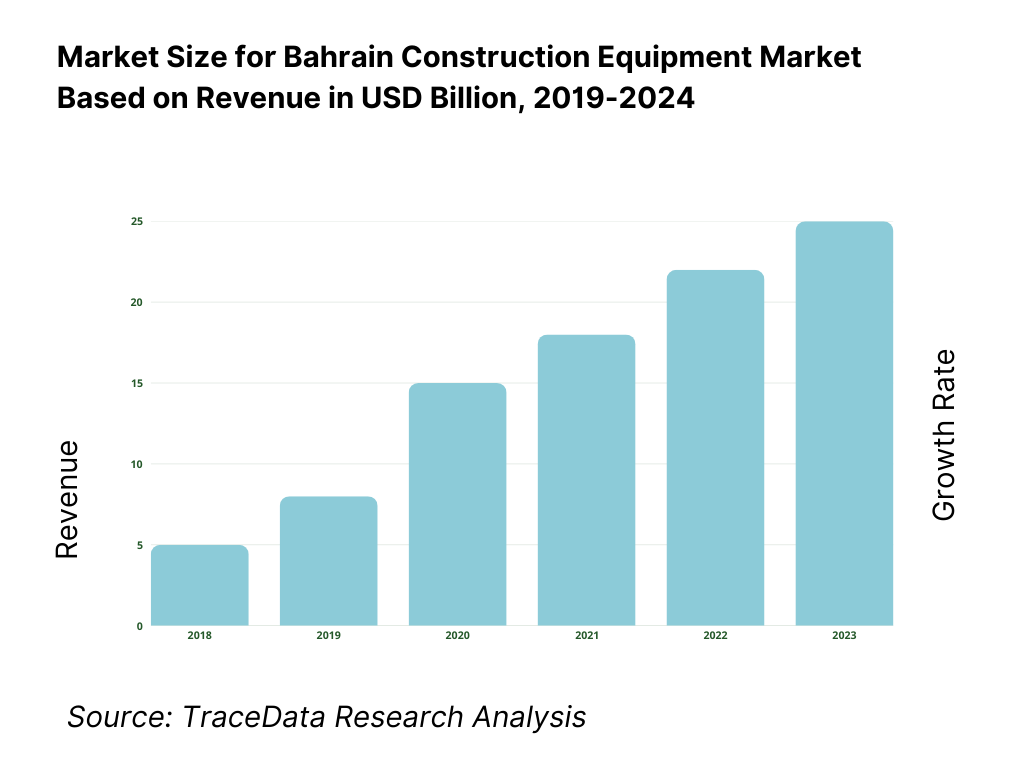
What Factors are Leading to the Growth of the Bahrain Construction Equipment Market:
Public procurement & infrastructure pipeline: Bahrain’s central e-tendering regime continues to catalyze equipment demand through a large, transparent project pipeline. In 2024, the Tender Board logged 5,554 bids and a BHD 2.112 billion total value of tenders—directly feeding road, utilities, housing and port contracts that require earthmoving, lifting and paving fleets. The Board’s own data are complemented by monthly awarded-tenders bulletins and an annual report that documents awards distribution across ministries and state-owned entities, underpinning steady equipment off-take throughout 2024 and into 2025. These hard procurement volumes translate into consistent machine hours for contractors and rental companies across Manama, Muharraq and the Northern/Southern governorates.
Diversifying, investment-backed non-oil economy: Macroeconomic capacity to fund construction is supported by growth in non-oil activity and fresh foreign capital. Bahrain’s Ministry of Finance & National Economy reports BHD 17,713.3 million GDP at current prices in 2024, with non-oil activities at BHD 15,395.6 million, indicating real economy depth that drives civil works, buildings and industrial projects. In parallel, the government recorded BHD 1.0 billion in 2024 FDI inflows, led by financial and insurance services, which translate into physical developments requiring machines for site prep, utilities and logistics backbones. IMF and World Bank profiles corroborate macro scale: GDP at current prices near USD 47–48 billion in 2024, supporting contractor balance sheets and equipment financing appetite.
Urban demand & streamlined building-permit throughput: End-market activity is visible in the permit pipeline and population base that concentrates worksites in urban corridors. The national news agency confirms 6,550 building permits issued in 2024, including 1,780 processed through the Benayat platform with an average approval time of two working days—converting quickly into excavation, concreting and access-equipment hours. World Bank data show a 2024 population of 1,588,670 supporting metropolitan construction demand around Manama and Muharraq. Together with the Benayat Building Code v2.0 issuance on 14 Aug 2024, which unifies permit rules and digital workflows, approvals translate to active sites requiring cranes, loaders and compaction fleets.
Which Industry Challenges Have Impacted the Growth of the Bahrain Construction Equipment Market:
Seasonal work-hour restrictions and productivity planning: Bahrain’s statutory midday work ban pauses outdoor activity between 12:00–16:00 during peak-heat months, compressing equipment utilization windows and requiring shift re-sequencing. The Ministry of Labour confirmed the 2024 enforcement from 1 July to 31 August with the same four-hour daily suspension, a strict occupational-safety control that affects excavation, asphalt laying, and heavy lifts under direct sun. The official news agency reiterated the ban’s parameters—work in open places is prohibited within the stated hours—necessitating additional night shifts and idling safeguards on diesel fleets to protect engines and operators. For rental and contractors, this legally defined downtime is a real scheduling constraint in 2024, not a discretionary practice.
Oversize/overweight logistics permitting for equipment moves: Moving large machines between urban jobs requires permits once thresholds are crossed. The national portal defines “unusual cargo” as any truck-plus-load above 40 tons gross weight, 18 m length, 4 m height or 2.5 m width; for multi-axle trailers, axle thresholds are 11.18 tons (four-wheel axle) and 15.18 tons (eight-wheel axle). Many crawler cranes, long-boom platforms and dozers exceed at least one of these limits when transported, triggering route clearances and timing windows that add planning complexity. These numeric limits applied throughout 2024 and 2025 constrain short-notice mobilization between sites, particularly through dense corridors in Manama/Muharraq or where bridge clearances are tight.
Bidding complexity for SMEs amid heavy procurement volumes: While public spending supports demand, smaller contractors face compliance load across high tender volumes. The Tender Board recorded BHD 2.112 billion tenders and 5,554 bids in 2024, reflecting intense competition and documentation requirements that favor larger players with bid-management capacity. The Board’s annual reporting also notes 294 government purchases awarded to SMEs in 2024, indicating that, although access exists, submission quality, financial bonds and post-award performance guarantees remain hurdles for many smaller fleets. The numeric scale of bids and awards is a practical, data-backed constraint that affects equipment acquisition decisions (own vs. rent) in 2024–2025.
What are the Regulations and Initiatives which have Governed the Market:
Unified digital permitting with Benayat + Building Code v2.0: Bahrain operates the Benayat portal as the single window for building permits; the Unified Guidebook of Building Permit Regulations v2.0 was issued on 14 Aug 2024, codifying submission standards and inter-agency clearances. Applications must be filed by engineering offices licensed by CRPEP, as restated in the official Benayat guideline manual. The policy is not cosmetic: the state disclosed 6,550 permits in 2024, including 1,780 processed via Benayat with two-day average approvals—hard throughput that directly governs when foundations and structural works can begin
Occupational safety: legally mandated midday work ban: The Ministry of Labour’s edicts enforce a summer stop on outdoor tasks from 12:00 to 16:00. In 2024, the ministry announced the ban for 1 July–31 August, and national media carried the same parameters—no outdoor work in direct sun within those hours. For equipment owners, this regulation hard-codes planning constraints into method statements, lift plans and paving schedules, and influences fleet sizing (e.g., additional rollers or mixers to compress tasks into available windows). Strict timing is a legal requirement observed in 2024 inspections and remains in force in 2025 edicts.
Heavy-transport permits for unusual loads: The national service rulebook requires permits for “unusual cargo” when a vehicle plus load exceeds 40 tons gross, 18 m in length, 4 m in height or 2.5 m in width; axle maxima for multi-axle trailers are 11.18 tons (four-wheel axle) and 15.18 tons (eight-wheel axle). This policy governs how cranes, oversized booms, piling rigs and dozers move across Bahrain’s network, requiring route approvals and time-of-day restrictions. It was active throughout 2024–2025 and is directly relevant to contractors and rental firms planning mobilization sequences and escort logistics for high-capacity equipment.
Bahrain Construction Equipment Market Segmentation
By Equipment Type: The Bahrain construction equipment market features Earthmoving Equipment—including excavators, backhoe loaders, and bulldozers—which dominates. This dominance stems from the extensive earthworks mandated by large-scale infrastructure and real estate projects, such as the Bahrain Bay waterfront expansion, King Fahd Causeway enhancements, and new industrial parks. Earthmoving machinery is essential in site preparation, grading, and land reclamation, all foundational stages across the construction value chain. As these high-intensity activity areas concentrate in Manama and the Northern Governorate, demand for robust, high‑tonnage excavators and dozers remains consistently elevated, reinforcing earthmoving equipment as the leading category in market share.
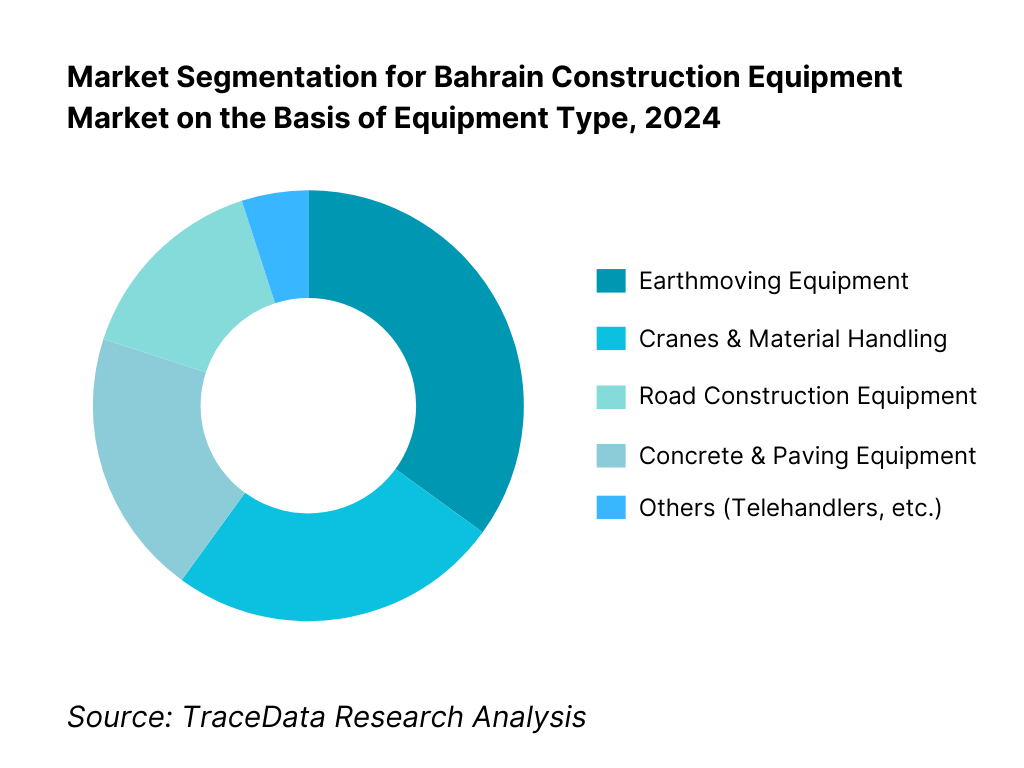
By Application: Infrastructure and Real Estate segments dominates the market. Infrastructure projects—including road networks, bridges, causeway expansions, and the proposed metro system—drive significant demand for heavy machinery due to the intensive earthmoving, piling, and structural work involved. Simultaneously, Real Estate development—encompassing residential towers, commercial malls, and mixed-use districts such as Bahrain Bay—fuels demand for cranes, concrete pumps, and compact excavators. Together, these two applications command over half the market’s value. Their dominance is rooted in sustained government infrastructure spending and private-sector urban development, particularly in high-density zones like Manama, where project complexity heightens the preference for reliable, high-capacity equipment.
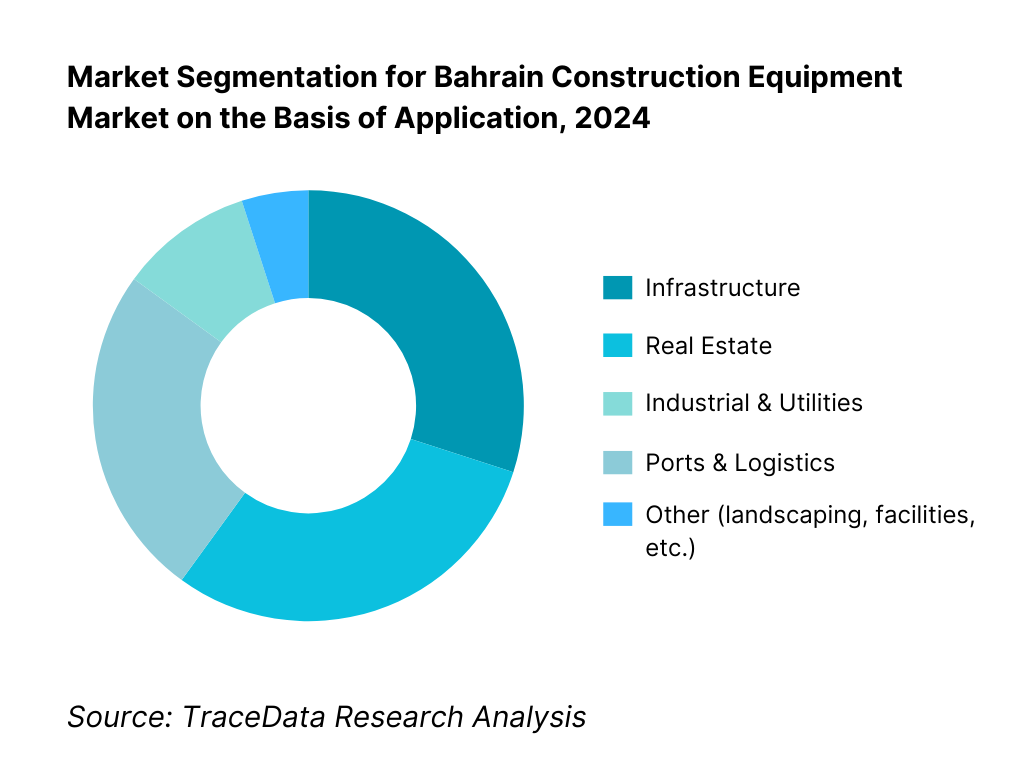
Competitive Landscape in Bahrain Construction Equipment Market
The Bahrain construction equipment landscape is concentrated among a handful of major OEM-aligned distributors and rental specialists, including Mohammed Abdulrahman Al‑Bahar (Caterpillar), Y K Almoayyed & Sons (Komatsu), AMA Motors (Case/Liebherr/Kobelco), Kanoo Machinery (Bobcat/Grove), and Sarens Nass Middle East (heavy lift/rental). These players collectively anchor the market through exclusive brand alignments, comprehensive service capacities, and strong project-level penetration—underscoring a consolidated competitive environment.
Name | Founding Year | Original Headquarters |
Mohammed Abdulrahman Al-Bahar | 1937 | Sharjah, UAE |
Y.K. Almoayyed & Sons | 1940 | Manama, Bahrain |
AMA Motors (Case, Liebherr, Kobelco) | 1954 | Riffa, Bahrain |
Kanoo Machinery | 1967 | Manama, Bahrain |
FAMCO Bahrain (Volvo CE) | 1978 | Dubai, UAE |
Sarens Nass Middle East | 2003 | Manama, Bahrain |
Kanoo Cranes | 1990 | Manama, Bahrain |
Bobcat Rental Bahrain (Kanoo) | 2000s | Manama, Bahrain |
MAP Rentals | 2000s | Manama, Bahrain |
Hitachi Construction Machinery Middle East | 1970 | Tokyo, Japan |
Liebherr Middle East | 1949 | Bulle, Switzerland |
Manitowoc/Grove (via Kanoo) | 1902 | Wisconsin, USA |
Develon (Doosan) Middle East | 1896 | Seoul, South Korea |
XCMG Middle East | 1989 | Xuzhou, China |
JCB Middle East | 1945 | Rocester, United Kingdom |
Some of the Recent Competitor Trends and Key Information About Competitors Include:
Mohammed Abdulrahman Al-Bahar (Caterpillar): As the exclusive Caterpillar dealer for Bahrain, Al-Bahar expanded its rental and used-equipment offerings in 2024, driven by increasing demand from contractors seeking flexible fleet solutions. The company has also strengthened its digital footprint by promoting Caterpillar’s VisionLink telematics platform for predictive maintenance and fuel optimization.
Y.K. Almoayyed & Sons (Komatsu, Hino): With a longstanding presence in Bahrain’s construction machinery sector, Almoayyed has introduced advanced Komatsu excavators with enhanced fuel efficiency. In 2024, it invested in expanding its aftersales service workshops in Manama, addressing the growing importance of quick parts availability and reducing downtime for EPC contractors.
AMA Motors (Case, Liebherr, Kobelco): AMA Motors has expanded its product portfolio by introducing new Liebherr cranes tailored for infrastructure and oil & gas projects. In 2024, the company emphasized partnerships with major EPCs for large-scale heavy lift operations and reinforced its operator training programs in response to Bahrain’s workforce localization policies.
Kanoo Machinery (Bobcat, Grove/Manitowoc): Kanoo Machinery has seen an uptick in demand for Bobcat compact equipment, reflecting rising requirements in urban development and utilities maintenance. In 2024, the company rolled out a rental-specific offering for compact loaders and access platforms, catering to SMEs and smaller contractors that prefer flexible financing and lower upfront costs.
Sarens Nass Middle East: Specializing in heavy lift and engineered transport solutions, Sarens Nass has expanded its crane fleet capacity in Bahrain, introducing high-tonnage cranes to meet rising demand from oil & gas and industrial projects. In 2024, it secured contracts for critical lifting operations in refinery upgrades and logistics expansion, underscoring its strong position in niche heavy-lift segments.
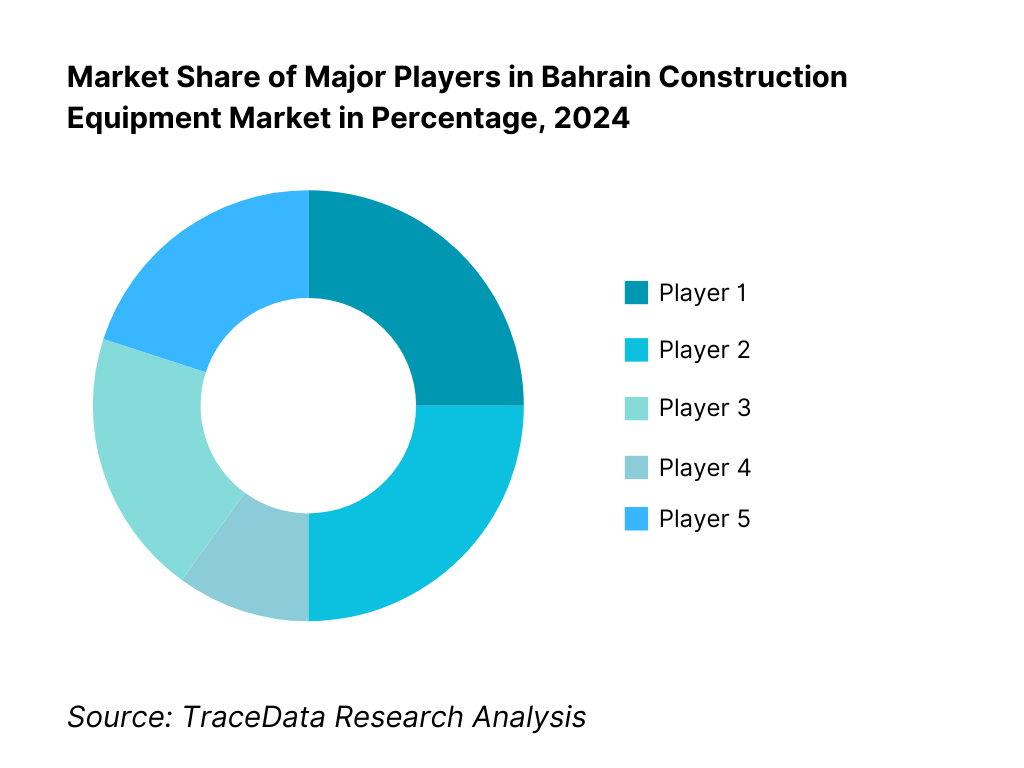
What Lies Ahead for Bahrain Construction Equipment Market?
The Bahrain construction equipment market is set for steady expansion through the medium term, underpinned by the government’s transparent e-tendering pipeline, ongoing urban regeneration around Manama/Muharraq, and continuing investments in transport, utilities, ports and industrial zones. Contractors will increasingly favor flexible acquisition models, outcome-linked service contracts, and machines that cut fuel burn and downtime. Digital permitting, faster award cycles, and workforce localization will further shape buying centers, while technology retrofits and lifecycle services become core differentiators for OEMs, dealers, and rental players.
Rise of Rental & Pay-Per-Use Models: Contractors are shifting capex to opex via short- and medium-term rentals, operating leases, and rent-to-own. This trend will accelerate as public works packages fragment across multiple parcels and timelines, requiring variable machine mixes—from compact loaders for urban utilities to high-tonnage cranes for industrial lifts. Expect rental providers to scale telematics-enabled fleets, guarantee uptime through SLAs, and offer bundled services (operator, fuel, maintenance) that reduce total job-cost volatility and improve bid competitiveness for Tier-2 contractors and SMEs.
Outcome-Based, Data-Driven Fleet Management: Telematics and machine-control add-ons will push the market toward outcome-based agreements—paying for productivity (m³ moved, km paved, lifts executed) rather than hours alone. Fleet analytics will optimize idle time, fuel burn, and preventive maintenance windows, while remote diagnostics shorten service cycles and parts dispatch. On major road, port and utility corridors, EPCs will standardize grade-control and payload monitoring to cut rework, integrate with BIM schedules, and document compliance—turning data transparency into a contractual lever during tender evaluation and project audits.
Sector-Specific Equipment Specialization: Demand will skew toward application-ready configurations: quarry-spec loaders and breakers for aggregates; long-reach excavators and piling rigs for waterfront works; high-capacity mobile/tower cranes for industrial plants; compact electrics and telehandlers for dense urban jobs; and specialized access platforms for maintenance in logistics parks and terminals. Dealers that hold deep inventories of niche attachments, safety packages, and quick-swap kits—and can mobilize transport/escorts rapidly—will capture higher wallet share across oil & gas, ports/logistics, utilities, and mixed-use real estate.
Electrification, Low-Emission Fuels & Circular Lifecycle: Early adoption of battery-electric and hybrid equipment will expand in indoor, night-shift and noise-sensitive zones, where lower emissions and acoustic profiles win permits and community acceptance. Parallel growth will come from HVO-ready engines, idle-reduction tech, and efficiency-focused hydraulics. Rebuild/reman centers, certified used programs, and component-exchange pools will lengthen asset life, lower lifecycle cost, and support ESG reporting. Suppliers that bundle carbon-intensity dashboards and compliance documentation will gain preference in public tenders and international JV projects.
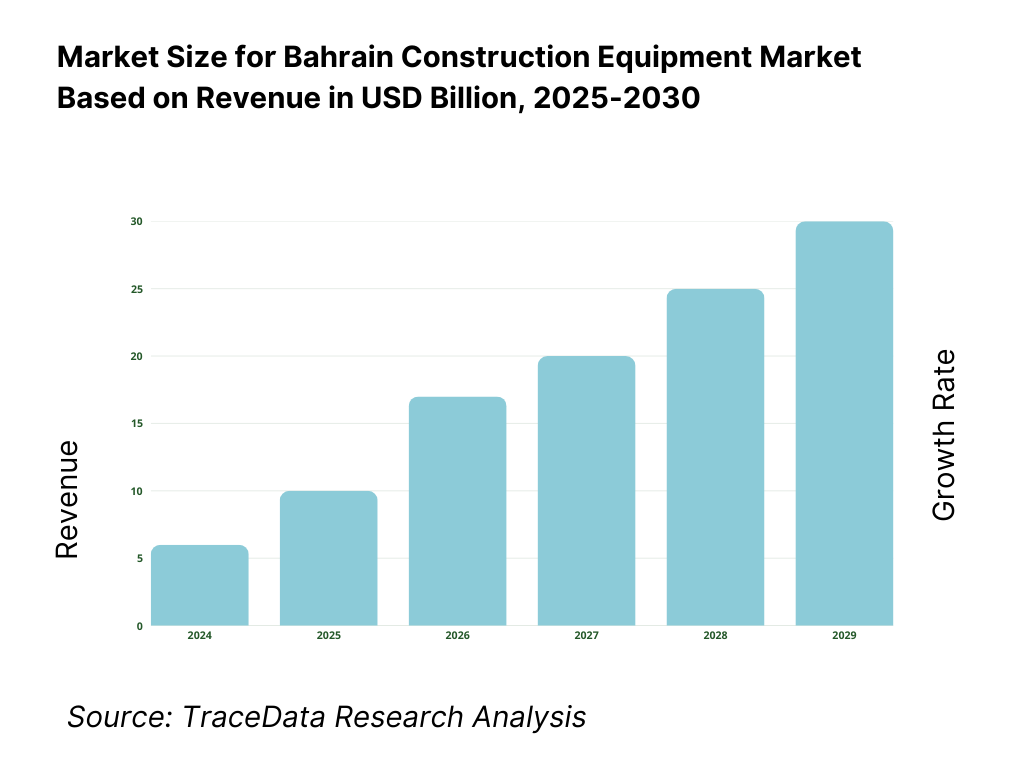
Bahrain Construction Equipment Market Segmentation
By Equipment Type
Earthmoving Equipment
Material Handling Equipment
Road Construction Machinery
Concrete & Paving Equipment
Others
By Application
Infrastructure
Real Estate
Industrial & Utilities
Ports & Logistics
Others
By Powertrain / Fuel Type
Diesel Internal Combustion Engines
Hybrid Models
Battery-Electric Equipment
Dual-Fuel / Alternative Fuel Units (LNG, CNG, HVO-ready)
By Ownership Model
Owned Equipment (Contractor Fleet Purchase)
Rental / Lease (Short-term, Long-term, Rent-to-Own)
Secondary Market / Used Imports
By Capacity Class
Heavy Capacity (≥30-ton Excavators, ≥100-ton Cranes)
Medium Capacity (10–30-ton Excavators, 25–100-ton Cranes)
Compact / Light Equipment
Players Mentioned in the Report:
Mohammed Abdulrahman Al‑Bahar (Caterpillar)
Y K Almoayyed & Sons (Komatsu)
AMA Motors (Case, Liebherr, Kobelco)
Kanoo Machinery (Bobcat, Grove/Manitowoc)
FAMCO Bahrain (Volvo CE)
Sarens Nass Middle East
Kanoo Cranes
Bobcat Rental Bahrain (Kanoo)
MAP Rentals
Hitachi Construction Machinery Middle East
Liebherr Middle East
Manitowoc/Grove (via Kanoo)
Develon (Doosan) Middle East
XCMG Middle East
JCB Middle East
Key Target Audience
Equipment rental companies
EPC contractors
Logistics and port authorities (e.g., Bahrain Port Company)
Real estate developers
Utilities and infrastructure agencies (Ministry of Works, Electricity & Water Authority)
Investment and venture capitalist firms
Industrial zone regulators (e.g., Bahrain International Investment Park Authority)
Government and regulatory bodies
Time Period:
Historical Period: 2019-2024
Base Year: 2025
- Forecast Period: 2025-2030
Report Coverage
Choose individual sections to purchase. Mix and match as you like.
- -
- -
- $100
4.1 Delivery Model Analysis for Construction Equipment-Direct Purchase, Lease, Rental, Auction Import (Margins, Contractor Preference, Strengths and Weaknesses)
4.2 Revenue Streams for Construction Equipment Market (New Equipment Sales, Rental Income, Used Equipment Sales, Aftermarket Parts, Service Contracts, Extended Warranty, Digital Telematics Subscriptions)
4.3 Business Model Canvas for Bahrain Construction Equipment Market (OEMs, Dealers, Rental Players)
$2505.1 Organized OEM Dealers vs Independent Importers
5.2 Investment Model in Bahrain Construction Equipment Market (CAPEX vs OPEX, Leasing, Rent-to-Own)
5.3 Comparative Analysis of Procurement & Tendering Process: Government vs Private Contractors
5.4 Equipment Budget Allocation by Contractor Size (Tier-1 EPCs, Tier-2 Contractors, SMEs)
$150- $100
- $200
8.1 Revenues & Units, 2019-2024
8.2 Key Growth Milestones
$3009.1 By Market Structure (Owned Fleet vs Rental/Leased)
9.2 By Equipment Type (Excavators, Loaders, Cranes, Compaction, Pavers, Concrete Pumps, Telehandlers, Access Equipment, etc.)
9.3 By Application (Earthworks, Roads & Bridges, Utilities, Housing, Oil & Gas EPC, Ports & Logistics)
9.4 By Powertrain/Fuel Type (Diesel, Hybrid, Electric, Alternative Fuels)
9.5 By Capacity Class (Excavator Ton Bands, Crane Capacity Bands, Loader Bucket Sizes)
9.6 By End-User Industry (EPC Contractors, Government Entities, Quarrying/Mining, Rental Providers, Utilities)
9.7 By Sales Channel (Direct OEM, Authorized Dealer, Distributor, Auction/Secondary Imports)
9.8 By Region (Capital, Muharraq, Northern, Southern Governorates)
$40010.1 Contractor & Developer Cohort Analysis (Procurement Criteria, Fleet Composition, Financial Preference)
10.2 Equipment Requirement Mapping by Project Pipeline (Transport, Housing, Oil & Gas, Utilities, Ports/Logistics)
10.3 ROI & Productivity Analysis (Fuel Burn, Downtime Costs, TCO Models, Utilization %)
10.4 Gap Analysis Framework
$50011.1 Trends & Developments (Electrification, Telematics, Rental Pay-Per-Use, Fleet Refurbishment, Contractor Consolidation)
11.2 Growth Drivers (Infrastructure Spending, Housing, Oil & Gas EPC, Logistics Expansion)
11.3 SWOT Analysis for Bahrain Construction Equipment Market
11.4 Issues & Challenges (Heat Stress Regulations, High Equipment Cost, Skilled Operator Shortage, Import Dependence)
11.5 Government Regulations (Tender Board Procurement, Building Permits/Benayat, Environmental Licensing, Midday Work Ban, Axle Load Restrictions, Safety Standards for Lifting & Access Equipment)
$20012.1 Market Size and Potential of Digital Equipment Telematics & Rental Platforms
12.2 Business Models & Revenue Streams (OEM Telematics Subscriptions, Rental Apps, Predictive Maintenance Services)
12.3 Delivery Models (OEM Integrated Platforms vs Independent Solutions)
12.4 Cross Comparison of Leading Digital/Telematics Platforms in Bahrain & GCC (Company Overview, Subscribers, Fleet Coverage, Pricing, Technology, Key Clients)
$500- $250
- $150
15.1 Market Share of Key Players (by Revenues, Units, Rental Fleet)
15.2 Benchmark of Key Competitors (Company Overview, USP, Product Portfolio, Number of Machines, Pricing, Technology, Clients, Strategic Tie-Ups, Recent Developments)
15.3 Operating Model Analysis Framework
15.4 Gartner Magic Quadrant for Equipment & Rental Providers
15.5 Bowmans Strategic Clock for Competitive Advantage
$75016.1 Revenues & Units, 2025-2030
$30017.1 By Market Structure (Owned Fleet vs Rental/Leased)
17.2 By Equipment Type
17.3 By Application
17.4 By Powertrain/Fuel Type
17.5 By Capacity Class
17.6 By End-User Industry
17.7 By Sales Channel
17.8 By Region (Capital, Muharraq, Northern, Southern)
$400- $250
- $250
Research Methodology
Step 1: Ecosystem Creation
We begin by mapping the Bahrain construction equipment ecosystem, covering both demand-side and supply-side entities. On the demand side, this includes EPC contractors, government ministries (e.g., Ministry of Works, Municipalities Affairs & Urban Planning, Tender Board), developers, logistics/port operators, and utilities (EWA, SCE). On the supply side, it covers OEMs, authorized dealers, rental companies, financing institutions, and service providers. From this mapped ecosystem, we shortlist 5–6 leading equipment distributors and rental companies in Bahrain such as Al-Bahar (Caterpillar), Y.K. Almoayyed & Sons (Komatsu), AMA Motors (Case, Liebherr), Kanoo Machinery (Bobcat, Grove), FAMCO (Volvo CE), and Sarens Nass Middle East, based on financial capacity, fleet size, service footprint, and project client base. Sourcing is conducted through official tender board publications, government reports, industry articles, and proprietary databases to collate market-level information.
Step 2: Desk Research
The next phase involves comprehensive desk research drawing on a wide array of secondary and proprietary databases. We analyze Bahrain’s macroeconomic construction indicators (GDP contributions, building permits, FDI inflows), import statistics by HS codes (8429, 8430, 8705), and Tender Board records of awarded infrastructure contracts. At the industry level, we review the number of dealers, rental operators, fleet compositions, and service workshops. At the company level, we examine press releases, audited statements (where available), and group-level financial disclosures. We also study public information such as tender bid submissions, awarded project reports, and Ministry of Finance economic bulletins. This desk research establishes a foundational understanding of market revenues, fleet sizes, ownership models, and competitive positioning.
Step 3: Primary Research
To validate our desk findings, we conduct in-depth interviews with stakeholders across the Bahrain construction equipment market. These include C-level executives at dealer principals (e.g., Al-Bahar, Almoayyed, AMA Motors), rental managers at MAP Rentals or Kanoo, and procurement heads at Tier-1 contractors. Interviews are designed to verify revenue contributions, financing norms, and equipment utilization rates. To ensure data authenticity, we also execute disguised interviews, approaching companies as potential clients to confirm service terms, pricing ranges, and fleet availability. These interactions yield insights into value chains, aftermarket services, pricing dynamics, operator training practices, and tender participation models, which are then cross-verified against secondary sources.
Step 4: Sanity Check
Finally, we implement a sanity check by combining both bottom-to-top (aggregating revenues and fleets of major suppliers) and top-to-bottom (cross-validating against government contract volumes and equipment import values) approaches. We model market size using reconciled inputs from tender spending (BHD 2.1 billion in 2024 tenders), import statistics, and company-level data, ensuring all outputs are consistent with Bahrain’s macroeconomic profile and project pipeline. This dual validation process ensures the robustness and accuracy of our market sizing and growth trajectory assessments.
FAQs
01 What is the potential for the Bahrain Construction Equipment Market?
The Bahrain Construction Equipment Market is poised for sustained expansion, underpinned by a transparent public‐procurement pipeline, steady urban regeneration in Manama/Muharraq, and continued development across transport, utilities, ports/logistics, and industrial zones. Rising contractor preference for rental, lease, and outcome-linked service models further broadens addressable demand beyond outright purchases. Digital permit workflows (Benayat), faster award cycles, and an emphasis on uptime, safety, and lower emissions are shifting buyer criteria toward telematics-enabled machines, lifecycle services, and specialized attachments—collectively strengthening medium-term market potential.
02 Who are the Key Players in the Bahrain Construction Equipment Market?
The competitive field blends global OEMs, regional principals, and strong local distributors/renters. Prominent names include Mohammed Abdulrahman Al-Bahar (Caterpillar), Y.K. Almoayyed & Sons (Komatsu), AMA Motors (Case, Liebherr, Kobelco), Kanoo Machinery (Bobcat, Grove/Manitowoc), FAMCO (Volvo CE), Sarens Nass Middle East, Kanoo Cranes, Bobcat Rental Bahrain, MAP Rentals, Hitachi Construction Machinery Middle East, Liebherr Middle East, Manitowoc/Grove (via Kanoo), Develon (Doosan) Middle East, XCMG Middle East, and JCB Middle East. Their entrenched brand authorizations, parts/service networks, and project penetration shape the market’s structure.
03 What are the Growth Drivers for the Bahrain Construction Equipment Market?
Growth is propelled by sustained government infrastructure spending and private real-estate activity, which translate directly into equipment hours across earthmoving, lifting, paving, and concrete works. Streamlined building permits via Benayat and coordinated approvals compress pre-construction timelines, accelerating fleet mobilization. Ports/logistics upgrades and industrial-park activity spur specialized lifting and material-handling demand, while oil & gas and utilities projects require high-capacity, application-ready machines. Rising adoption of telematics, machine control, and outcome-based contracting also increases replacement and retrofit cycles, reinforcing new equipment, used, and rental demand.
04 What are the Challenges in the Bahrain Construction Equipment Market?
Contractors and rental firms must plan around legally mandated midday outdoor-work bans in peak-heat months, which compress usable shifts and complicate utilization and scheduling. Oversize/overweight transport restrictions add routing/permit complexity for cranes, long-boom platforms, piling rigs, and large dozers moving between dense urban corridors. Smaller contractors face bid-management and compliance burdens in high-volume public tendering, including bonds, documentation, and post-award KPIs, which can tilt awards toward larger firms with deeper working capital and established HSE/quality systems. Financing availability and operator upskilling needs add further execution risk.